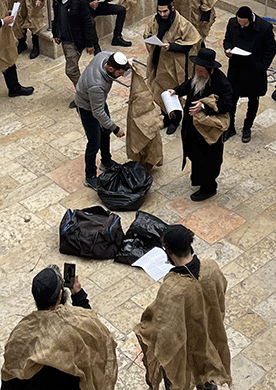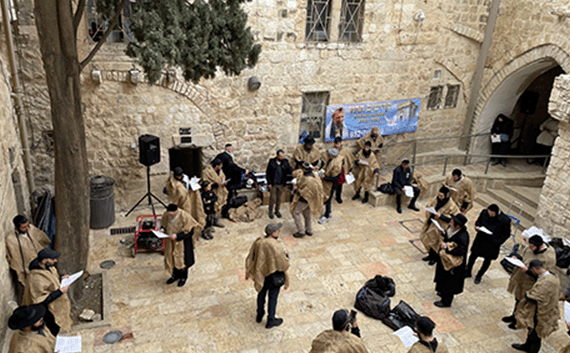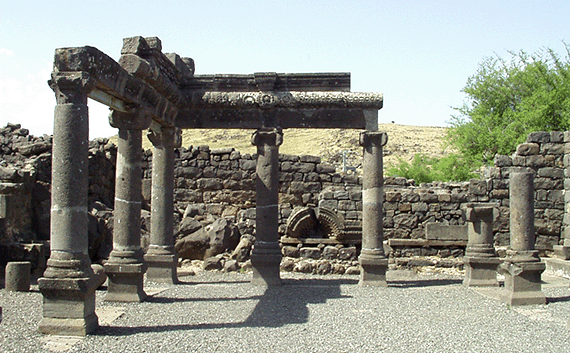|
|
|
 |
|
“WHEN MORDECAI
LEARNED ALL THAT HAD HAPPENED, HE TORE HIS
CLOTHES AND PUT ON SACKCLOTH AND ASHES, AND WENT OUT INTO THE
MIDST OF THE CITY. HE CRIED OUT WITH A LOUD AND BITTER CRY. "
ESTHER 4:1
|
|
Ask Gila why the men are wearing sackcloth
|
In March 2022, while descending the stairs from the
Upper Room into the courtyard of King David’s tomb,
my group and I encountered about two dozen men
donning sacks over their black suits. In the
middle of their circle, a rabbi was preaching to a
crowd of about forty. |
| |
|
 |
I was astounded.
Of course I was familiar with the biblical
expression sackcloth and ashes but I had never seen
anyone actually wearing sackcloth. I
approached a group of women opposite us who were
eager to inform me that day was "tan'anit Esther"
meaning the Fast of Esther. They had come from
all over Israel to attend the ceremony with this
particular rabbi. If we remember the story of
Esther, the lovely Jewish maiden won a beauty
contest with the prize being marriage to the Persian
king Ahasuerus. Not too long afterwards, Haman,
the king's closest adviser convinced him that the
Jews were conspiring against his laws and should be
eliminated.
A decree was sent out in the king's name that all
Jews, young and old, including women and children
were to be annihilated on the thirteenth day of the
twelfth month, the month of Adar. |
|
Choosing a sackcloth in the
courtyard of King David's tomb |
|
| |
| When Mordechai, Esther’s uncle heard about the
impending genocide, he tore his clothes and put on
sackcloth and ashes, the ancient Jewish symbol of
mourning. |
| |
| Sack, by the way, is a Hebrew word, used more than
forty times in the Hebrew bible. Sack originally
denoted a coarsely woven fabric, usually made of
goat's hair. It afterwards came to mean also a
garment made from such cloth. |
| |
| The first reference in the bible to sackcloth is
when Joseph’s blood-stained ornamental tunic was
brought by the brothers to Jacob, proof that his
beloved son Joseph was dead. “Jacob tore his
clothes, put sackcloth on his waist, and
mourned for his son many days.” (Genesis
37:34) |
| |
| It
wasn’t just an Israelite custom, for we read in the
book of Jonah (chapter 3) that the people of Nineveh
trusted Jonah’s prophecy of destruction. “And
the people of Nineveh trusted God, proclaimed a
fast, and put on sackcloth, from the greatest
to the least of them. and the king followed suit,
throwing aside his robe, covering himself with
sackcloth and sat upon ashes.” (Jonah 3:5) |
| |
|
 |
|
Photo: Gila Yudkin |
|
Ceremony with sackcloth during the
Fast of Esther, one day before Purim |
| |
| When
Esther heard that Uncle Mordecai, clothed in
sackcloth, was standing at the gates of the palace,
she sent a servant with garments for him to change
into, so he could enter the palace. Mordecai
refused. Instead, he sent her a copy of the
written decree declaring the imminent destruction of
the Jews. He urged Esther to plead with the
king to rescind the decree and save her people. |
|
|
|
Thus Esther decided to face the king, without his
prior permission, risking certain death. She
told her uncle Mordechai to gather all the Jews
present in the Persian capital to fast for three
days and nights. And she said, “My maids and I
will fast likewise. And so I will go to the
king, which is against the law; and if I perish, I
perish!” (Esther 4:16) |
|
|
|
This is the origin of Taanit Esther, the Fast of
Esther, a dawn to nightfall fast held on the day
before the Jewish holiday of Purim. Purim is a
raucous holiday. The Book of Esther is read in its
entirety, with groggers, or noise-rattlers drowning
out the name of Haman, the king’s henchman whenever
mentioned. |
|
|
|
Purim combines elements of Halloween, with
costumes depicting the good and bad guys, along with
modern pop figures, Mardi Gras with floats and
parades and Near Year’s Eve with uproarious drinking
and the celebration of hope. The rabbis say that one
should drink so much wine that one cannot
distinguish between “blessed be Mordechai and cursed
be Haman!” |
|
|
|
Copyright 2025 Gila Yudkin. Permission
needed for any reuse. |
|
|
|
And what did Jesus say about sackcloth and ashes?? |
|
|
|
 |
|
Photo: Gila Yudkin |
|
Jesus prophesized that residents
of Chorazin would be donning sackcloth and ashes |
|
|
|
On our visit to Chorazin, and/or Bethsaida, we
quote from Matthew or Luke.
“Woe to you, Chorazin! Woe to you, Bethsaida! For if
the mighty works which were done in you had been
done in Tyre and Sidon, they would have repented
long ago, sitting in sackcloth and ashes. Luke 10:
13 |
|
|
|
Come with Gila on tour for surprises and spontaneity
as the biblical word acquires color and context. |
|
|
| |
| In "Let's
Echo the Reproach to
Chorazin" Gila
describes and illustrates the highlights of
a visit with her to the ruins of the Galilean town of
Chorazin. |
| |
|
According to the prophet Zechariah, on the
"day of the lord" which is coming (hopefully
soon!), the Mount of Olives will split in
two, half of it moving towards the north and
half towards the south. Before that,
here are eight fun things to
do on the Mount
of Olives in Jerusalem! |
| |
| If you are coming to Jerusalem by yourself
and plan to visit the Temple Mount,
Gila's MP3
Temple Mount audio tour
will expose you to its many facets:
Jewish, Christian, Muslim plus archeological,
historical and legendary. Tour the Temple
Mount in the company of Abraham and Isaac,
David and Solomon, Jesus and the disciples, Mohammed and the
archangel Gabriel. |
| |
| If you
prefer a written guide, rather than an
audio, order
Gila's Temple Mount tour
in PDF format. In addition to the
one-hour tour, there is a Temple Mount plan,
guidelines to pass the security check and
the ten best reads on the Temple Mount on
Gila's bookshelves. |
|
|
|
GILA
YUDKIN
•
TCHERNIKOVSKI
64A
•
JERUSALEM
•
ISRAEL
gila@itsgila.com
HOME
•
BOOK
GILA
•
TIPS
FOR TOURS •
ABOUT GILA
|
|

